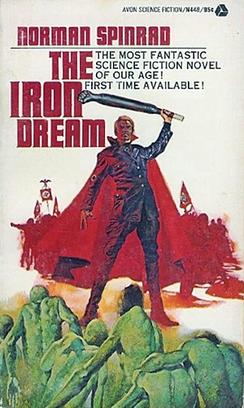New Book of the Week: The Iron Dream
Every now and then in SF literature, an author throws you a googlie / curve ball (delete according to local cultural affinity to cricket or baseball; if you follow neither sport, we’re afraid you’re on your own). The Iron Dream is one of those occasions.
 A metafictional 1972 alternate history novel, based around a nested narrative that tells a story within a story. on the surface, the novel presents a rather visceral science fiction action tale entitled Lord of the Swastika. But this is a pro-fascist narrative written by an alternate history version of Adolf Hitler, who in this timeline emigrated from Germany to America and used his modest artistic skills to become first a pulp-SF illustrator and later a science fiction writer in the L. Ron Hubbard mould (telling lurid, purple-prosed adventure stories under a thin SF-veneer).
A metafictional 1972 alternate history novel, based around a nested narrative that tells a story within a story. on the surface, the novel presents a rather visceral science fiction action tale entitled Lord of the Swastika. But this is a pro-fascist narrative written by an alternate history version of Adolf Hitler, who in this timeline emigrated from Germany to America and used his modest artistic skills to become first a pulp-SF illustrator and later a science fiction writer in the L. Ron Hubbard mould (telling lurid, purple-prosed adventure stories under a thin SF-veneer).
Lord of the Swastika is gloriously over-the-top – a blatant piece of pro-Nazi propaganda masquerading as pulp SF adventure. But The Iron Dream, even though it comprises in large part of Lord of the Swastika is an altogether different beast, a prime example of Norman Sprinrad’s exquisite skill as a writer.
The nested narrative is followed by a faux scholarly analysis by a fictional literary critic, Homer Whipple, of New York University, which ruthlessly exposes the cliches, racism and homoerotic imagery that riddles pulp-writer-Hitler’s novel.
Alvaros Zino-Amaro, writing in The Los Angeles Review of Books, observes:
Purportedly written by a hack writer, Lords of the Swastika stays true to its propagandistic vision and showers us with page after page of jingoistic, eugenics-obsessed purple prose and phallus-centric power fantasies . . . We are told of the rise to power of “genetic true man” Feric Jaggar, who becomes head of the Human Renaissance Party, triumphs in a series of character-testing perils . . . and thereby discovers he is the rightful heir to the glorious weapon Great Truncheon of Held.
Zino-Amaro goes on to note the reactions of Ursula K. Le Guin and Thomas M. Disch to the novel and its further examination by other critics. The piece – focussing on five of Spinrad’s works – is quite long but well worth reading as an insight into one of SF’s most vibrant, original and, on occasion, controversial voices.
You can find more of Norman Spinrad’s work via his Author page on the SF Gateway website, and read about him in his entry in The Encyclopedia of Science Fiction.

